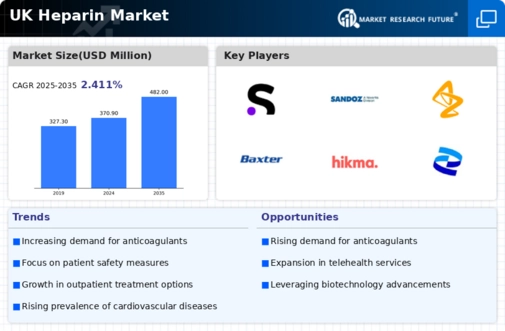Rising Geriatric Population
The demographic shift towards an aging population in the UK is a significant driver for the heparin market. As the elderly population grows, the prevalence of age-related health issues, including thromboembolic disorders, is likely to increase. The Office for National Statistics reports that by 2040, the number of people aged 65 and over is projected to reach 23% of the total population. This demographic change suggests a heightened demand for anticoagulants, particularly heparin, which is widely used in managing such conditions. Healthcare providers may increasingly prescribe heparin to this demographic, thereby expanding its market share. The implications of this trend are profound, as the heparin market must adapt to meet the needs of an aging population, ensuring that effective treatment options are readily available.
Advancements in Clinical Guidelines
The evolution of clinical guidelines regarding anticoagulation therapy is a notable driver for the heparin market. As medical research progresses, updated guidelines are being established to optimize patient outcomes in anticoagulation management. The National Institute for Health and Care Excellence (NICE) regularly reviews and updates its recommendations, which often include the use of heparin for various indications. These advancements in clinical practice not only enhance the safety and efficacy of treatments but also encourage healthcare professionals to adopt heparin as a preferred option. Consequently, the heparin market is likely to benefit from increased adoption rates as clinicians align their practices with the latest evidence-based guidelines. This trend underscores the importance of continuous research and development in shaping the future of anticoagulation therapy.
Expansion of Healthcare Infrastructure
The ongoing expansion of healthcare infrastructure in the UK significantly influences the heparin market. With the government investing heavily in healthcare facilities, the accessibility of advanced medical treatments is improving. This expansion includes the establishment of new hospitals and clinics, which are likely to increase the demand for heparin as a standard treatment for various conditions. The National Health Service (NHS) has allocated substantial budgets for enhancing patient care, which includes the procurement of essential medications like heparin. As more healthcare facilities become equipped to provide comprehensive care, the utilization of heparin in clinical settings is expected to rise, thereby driving market growth. This trend indicates a positive outlook for the heparin market, as increased healthcare access correlates with higher medication usage.
Growing Focus on Preventive Healthcare
The increasing emphasis on preventive healthcare in the UK is a pivotal driver for the heparin market. As healthcare systems shift towards proactive management of health conditions, the role of anticoagulants like heparin becomes more pronounced. Preventive measures, including the use of heparin in at-risk populations, are gaining traction among healthcare providers. This shift is supported by public health campaigns aimed at reducing the incidence of thromboembolic events. The UK government has recognized the importance of preventive healthcare, allocating resources to promote awareness and education regarding anticoagulation therapy. As a result, the heparin market is poised for growth, as more individuals seek preventive treatments to mitigate their risk of developing serious health complications.
Increasing Prevalence of Cardiovascular Diseases
The rising incidence of cardiovascular diseases in the UK is a crucial driver for the heparin market. As conditions such as atrial fibrillation and deep vein thrombosis become more common, the demand for effective anticoagulants like heparin is expected to surge. According to recent health statistics, cardiovascular diseases account for approximately 27% of all deaths in the UK, highlighting the urgent need for effective treatment options. This trend is likely to propel the heparin market, as healthcare providers increasingly rely on heparin for its efficacy in preventing thromboembolic events. Furthermore, the growing awareness among patients regarding the importance of anticoagulation therapy may further stimulate market growth, as individuals seek preventive measures against these prevalent health issues.






















Leave a Comment